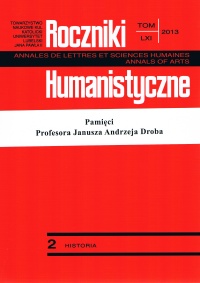„This is the bad Athenians’ Parliament, ours is not like that”, or about ancient Greece in the interpretation of Tribunal preachers
Abstract
Models taken from ancient Greece were fairly often used in speeches and sermons in Poland in the past; speakers, preachers and theoreticians writing about the Crown Tribunal willingly referred to them. Most often this was done in a positive context, although ancient Athens were also referred to when a negative model was to be shown. This was done by the Jesuits Piotr Dunin and Józef Kleczyński. Despite certain similarities to actual facts (transferring the Tribunal from Lublin to Jarosław because of the raging plague as an extraordinary event), it is hard to treat their sermons as descriptions of actual events, but rather as a peculiar result of the Lublin experience of several generations, gathered together for a didactic purpose, as a sort of anti-model. The image of Athens in Kleczyński's and Dunin's sermons is perfectly well inscribed into the topos of the town as an „evil place”, where all problems were concentrated that were considered the most dangerous for just judgments: corruption, drunkenness, fixing problems in an informal way.
References
Bednarska J.: Z dziejów polskiej ilustracji panegirycznej. Motywy i tematy antyczne w polskiej panegirycznej ilustracji książkowej, t. 1, Katowice 1994.
Bednarsk a J.: Z dziejów polskiej ilustracji panegirycznej. Problematyka stylistyczno- -formalna polskiej panegirycznej ilustracji książkowej, t. II, Katowice 2005.
Drob J. A.: Trzy zegary. Obraz czasu i przestrzeni w polskich kazaniach barokowych. Lublin 1998.
Dziok-Strelnik I.: Bibliografia starych druków lubelskich 1630-1800, Lublin 1997.
Encyklopedia wiedzy o jezuitach na ziemiach Polski i Litwy 1564-1995, oprać. L. Grzebień, Kraków 1996.
Gombin K.: Staropolskie relacje o lubelskim Ratuszu - siedzibie Trybunału Koronnego, „Prace Polonistyczne” 63 (2008).
Gombin K.: „Bankiety są wielką koruptelą Trybunalistów”. Uczty z udziałem deputatów w oczach współczesnych, w: Studia nad sztuką renesansu i baroku, red. J. Lileyko, I. Rolska-Boruch, t. IX, Lublin 2008.
Kus J.: Trybunał Koronny Lubelski w Jarosławiu - 1711, „Rocznik Stowarzyszenia Miłośników Jarosławia” 18 (2009-2010).
Pelczar S. J.: Zarys dziejów kaznodziejstwa w kościele katolickim, t. 11. Kraków 1896.
Pelczar S. J.: Zarys dziejów kaznodziejstwa w Polsce, Kraków 1917.
Pokora J.: Stanisławowi Augustowi panegiryk intarsją pisany (Drzwi w toruńskim ratuszu), „Rocznik Historii Sztuki” 19 (1992).
Popiołek B.: Królowa bez korony. Studium z życia i działalności Elżbiety z Lubomirskich Sieniawskiej ok. 1669-1729, Kraków 1996.
Tazbir J.: Korupcje, posuły, kubany i wziątki, w: Parlament, prawo, ludzie. Studia ofiarowane Profesorowi Juliuszowi Bardachowi w sześćdziesięciolecie pracy twórczej, red. K. Iwanicka, M. Skowronek, K. Stembrowicz, Warszawa 1996.
Copyright (c) 2013 Roczniki Humanistyczne

This work is licensed under a Creative Commons Attribution-NonCommercial-NoDerivatives 4.0 International License.





